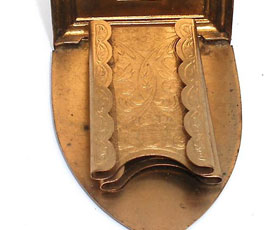Flat Iron

Design Representation

Design Representation
Design Details
Needle Case Type: |
Figural |
Patent/Registered to: |
J. Clarke & Son – Birmingham |
Patent/Design Representation #: |
Ornamental Class1: Metal: #334846 |
Patent/Design Registration Date: |
May 3, 1879 |
Location of Patent/Design Registration: |
The National Archives (TNA) - Kew, UK |
Reference #: |
TNA Representation - BT 43/45/334846
TNA Register - BT 44/4/334846 |
Dimensions: |
6.2 x 4.4 x 4 |
Material: |
Brass |
Name Variations: |
Unmarked |
Other Variations: |
a) With circular decoration
b) Without circular decoration |
Additional Photographs


Side view with circular decoration and open view


Top without circular decoration and bottom views (photos courtesy of Lynda Herrod)


Front and back (photos courtesy of Lynda Herrod)


Side and interior detail (photos courtesy of Lynda Herrod)

Interior detail (photo courtesy of Bunny's Place)
Facts
A flat iron, sometimes called a smoothing iron, consists of a flat, somewhat triangular shaped, cast iron body with a handle, to provide heat and
weight to remove wrinkles from cloth. Designed to be heated by hanging over or standing upright before the open hearth or at the kitchen
range, they were often sold as pairs to allow uninterrupted usage by swapping the pair as one became too cool to be effective. Care had to be
taken to ensure that the ironing surface was free from soot and with no temperature indicator, that the iron was not too hot for the fabric.
Reports describe testing with a wet finger, spitting to hear the sizzle, and holding close to the face as methods employed to check the heat but
perhaps the safest was trying it on a small piece of flannel.

History
Heat has been used to smooth out fabric since the 1st century in China where metal pans holding hot coals were passed over silk. A very
different approach was used by Vikings who used smooth cold materials like rock on damp cloth. By the 17th century heat was being used to
“iron” in Britain with solid flat irons and other varieties including those with a cavity to hold hot coals and others that held a metal insert or
iron slug that was heated on the fire. Several types of fuel heated irons were invented and employed until the electric iron became the
norm. The addition of refinements like thermostats and steam made the task of ironing less arduous but arguably no more enjoyable.

Miscellaneous
The term Flatiron has been used to describe wedge shaped buildings. Many are in North America and some in other parts of the world
including Sweden, the Netherlands and China. The most iconic of these is the 21 above ground floor, Flatiron Building in Manhattan, New York
City. Sitting on a triangular block it is credited as being one of the first sky scrapers. Completed in 1902 after a 1 year
construction, the building was designed by Chicago architect Daniel Burnham.

Note: Right side panel text and photos provided by Lynda Herrod.


















